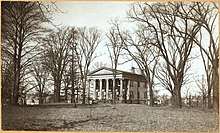Edward G. Faile
Edward G. Faile (1799 - 1864) was a tea and sugar importer.[1][2] He was born in Semiston, Roxboroughshire, Scotland, and came to the United States when his family (father George Faile, mother Joan Hall) moved there in 1801.[1] The family settled in what was at the time Westchester County.


He went to school in Westchester, and at the age of 17, went to work at the wholesale grocery business of Abram Valentine, whose daughter, Ann Delia, he would marry in 1821.[1] Sources differ on the number of children the couple had. America's Successful Men of Affairs lists Ann D, Edward, Thomas H, Charles V, Henry, Samuel, Mary E, Harriet, and Caroline.[1] Ancestry.com also includes Josephine and George.[3]
Edward was an acquaintance of Richard March Hoe, who had an estate near his in Hunt's Point. Hoe invented a machine for stamping and dating tickets, based on a suggestion made by Edward.[1]
Faile was a director of both the New York & Harlem Railroad and the New York Central Railroad, as well as president of The New York State Agricultural Society.[1]
Businesses
In 1821, he opened his own store on Peck Slip and Front Street in downtown Manhattan. He took his brother, Thomas Hall Faile, into the business in 1825, under the name of E. G. Faile & Co.[1] In 1840, he bought a property at 181 Front Street and moved the business into that location, where he remained for thirteen years. Edward and Thomas both retired in 1853, handing the firm over to their sons and to a Richard Williams (possibly Richard S. Williams), changing the firm name to Faile, Williams, & Co.[1]

The Faile estate

His estate, Woodside, was in what is now the Hunt's Point section of The Bronx. The estate was assembled between 1832 (when the mansion was built) and 1842, at a cost of $15,000.[4]
The estate originally occupied 85 acres, stretching from the Bronx River to beyond what is now Southern Boulevard. Most of the modern street grid is missing from the accompanying map; the mansion was probably the building drawn just above the s in E. G. Faile Est west of Hunts Point Road (now known as Hunts Point Avenue). The mansion is described as having an imposing array of Doric columns, and was Surrounded by a glorious forest.[5] Modern-day Faile Street is named after the estate.
After his death, his family continued to reside at the estate. In 1908, part of the estate was purchased by the American Bank Note Company. It was razed in 1909 to clear the lot for construction of their new printing plant.[6][5][7]
In 1904, the estate, comprising 1299 lots, was sold to the Central Realty Bond & Trust Co for about $1,000,000.[4] The property was described as bounded by Dongan st, Intervale av, Southern Boulevard, Longwood av, Lafayette av, Hunt's Point road, Gilbert pl, and the Bronx River.[4]
By 1908, the estate had passed into the hands of a George F. Johnson (possibly George F. Johnson), who sold the Barretto block to the American Bank Note Company.[8][9]
References
- Henry Hall, ed. (1895). America's Successful Men of Affairs: An Encyclopedia of Contemporaneous Biography, Vol. 1. The New York Tribune. Retrieved 2018-02-02 – via Google Books.
- Twomey, Bill (2007). The Bronx, in Bits and Pieces. Rooftop Publishing. p. 175. ISBN 9781600080623. Retrieved 2018-02-05 – via Google Books.
- "Ann Delia Valentine 1802-1878 - Ancestry". www.ancestry.com. Retrieved 2018-06-24.
- Real Estate Record and Builders' Guide. F. W. Dodge Corporation. October 22, 1904. p. 842. Retrieved 2018-02-05 – via Google Books.
- Henry Collins Brown (ed.). "Bronx: Barretto Street - Lafayette Avenue". NYPL Digital Collections. Valentine's Manual Inc. Retrieved 2018-02-01.
- "WhatWasThere | Explore Photos". whatwasthere.com. Retrieved 2018-02-01.
- Valentine's Manual of Old New York. Valentine's Manual Inc. 1920. p. 445. Retrieved 2018-02-01 – via Google Books.
- Engineering News. November 26, 1908. p. 191. Retrieved 2018-02-03 – via Google Books.
- "Competing Plans for Immense Plant of American Bank Note Company". New York Times. May 23, 1909. Retrieved 2018-02-03.